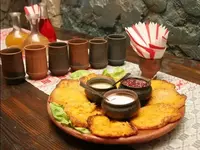The estonian

Estonian cuisine provides a tradition of cooking along with the national dishes of Estonians, by which it is most often customary to mean primarily typical peasant dishes until the middle of the 19th century. However, a little later, certain dishes became traditional and common. Swedish, German and Russian traditional cuisine had a rather strong influence on local cuisine at one time. I must say that compared to Lithuanian and Latvian, Estonian cuisine is considered more "marine. "
Food raw materials, cooking methods and compositional techniques of Estonian cuisine are quite simple. The most characteristic of the raw materials used are potatoes, pork and meat offal, fish (especially herring), milk, sour cream, peas, cabbage, cereals and black bread. Estonian cuisine is simple and nutritious, sometimes fatty. Traditional Estonian cuisine is characterized by boiling products in a liquid medium, and roasting is rarely used.
There are few seasonings and spices in recipes for Estonian cuisine. In addition to salt and onions, parsley, dill and cumin are traditionally consumed. Marjoram is added to blood sausages, and bay leaves and allspice are added when cooking jellyfish. The peculiar taste of ready-made dishes is achieved through unusual combinations of food raw materials (peas with milk, fish with pork lard). In general, the taste and aroma of Estonian cuisine can be described as natural, milky, slightly sour.
Until the 19th century, recipes for Estonian cuisine did not differ in variety. The main food was rye bread, along with which Estonians ate salted herring all year round. When Estonians were introduced to potatoes, it came second to bread and supplanted many popular dishes. It was customary to drink kvass or prostokvash, and beer was brewed on holidays.
To this day, kama (kama) is popular in Estonia - a dish based on tolokna from flour, which is made from pre-fried rye grains, barley, oats and peas, as well as fresh milk or prostokvashi. Oat jelly with butter or cold milk was consumed in some regions.
Variety in the diet of Estonians added ritual and festive dishes. For the holidays, gray bread "sepik" (sepik) was baked. By the New Year and Christmas, blood sausages (originally with cereal filling) appeared on the tables. Such sausage was supposed to bring contentment and happiness to the house. Jellies (sult) were always served at the wedding, and barley porridge or barley flour fritters were treated to the newborn's caretakers.
Today, the traditional Estonian "cold table" includes pickled herring with sour cream, whipped liver pate, jellied meat, Rosolye salad, potato salad, pickled cucumbers and pumpkin, mayonnaise meatballs, ham rolls with fillings and stuffed eggs.
Dairy products play a special role in Estonian cuisine. The daily diet of Estonians includes milk, yogurt, prostokvash, cottage cheese and homemade cheese. A typical breakfast is porridge, sandwiches or omelette, and recently a more western variant has spread - granola with yogurt. Estonians consume quite a lot of coffee, preferring light varieties of the Scandinavian type.
Soups are quite common in Estonia, among which potato, cabbage and pea are considered the most popular. Usually the meat in the first dishes is boiled in one piece, and the rest of the meal is represented by potatoes, cabbage or peas, carrots, pearl barley or pasta. Pea and bean soup most often include smoked pork.
The range of traditional sweet dishes of Estonian cuisine is quite diverse. It is represented by bread soup, jelly with milk or whipped cream, beaten semolina mousse from fruit juice, curd cream with jam, apple casserole, as well as pancakes with jam and various cakes.
 Español
Español Français
Français Português
Português Русский
Русский 简体中文
简体中文 繁體中文
繁體中文 日本語
日本語 한국어
한국어 العربية
العربية Türkçe
Türkçe Қазақ
Қазақ Deutsch
Deutsch Italiano
Italiano Українська
Українська
